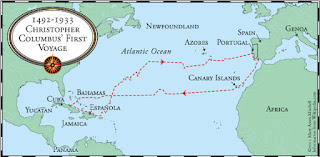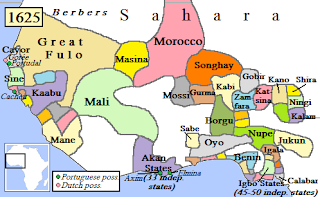THE GAO EMPIRE: fortified in riches
The Gao Empire precedes that of the Songhai Empire in the region of the Middle niger, its name comes from the town of Gao situated on the eastern Niger bend. In the ninth century CE, it was considered to be the most powerful and important West African kingdom.
Pre-Islamic history of Gao
The earliest mention of Gao is by al-Khwārizmī who wrote in the first phase of the 9th century.In the
9th century Gao was already an important regional power. Al-Yaqubi wrote in his Tarikh in around 872:
Ibn al-Faqih (writing c. 903) mentions a caravan route from Egypt to ancient Ghana via Kawkaw.
[7] but Ibn Hawqal (writing c. 988) states that the old route from Egypt to the Sudan was abandoned in the reign of the Egyptian ruler Ibn Tulun (ruled 868-884) as some of the caravans were attacked by bandits while others were conquered by the wind-blown sand.The more direct trade route was replaced by one that went to Sijilmasa before heading south over the Sahara.
9th century Gao was already an important regional power. Al-Yaqubi wrote in his Tarikh in around 872:
Ibn al-Faqih (writing c. 903) mentions a caravan route from Egypt to ancient Ghana via Kawkaw.
[7] but Ibn Hawqal (writing c. 988) states that the old route from Egypt to the Sudan was abandoned in the reign of the Egyptian ruler Ibn Tulun (ruled 868-884) as some of the caravans were attacked by bandits while others were conquered by the wind-blown sand.The more direct trade route was replaced by one that went to Sijilmasa before heading south over the Sahara.
The Gao Empire and the Almoravids
Two towns of Gao
The archaeological evidence suggests that therewere two settlements on the eastern shore of the Niger: Gao Ancien situated within the modern town, to the east of the Tomb of Askia, and the archaeological site of Gao-Saney (Sané in French) situated around 4 km to the east. The bed of the Wadi Gangaber passes to the south of the Gao-Saney occupation mound, but to the north of Gao Ancien. The imported pottery and glass recovered from Gao-Saney suggest that the site was inhabited between the 8th and 12th centuries. It is possible that Gao-Saney corresponds to Sarnāh of al-Muhallabi. Al-Bakri writing in 1068 also records the existence of two towns, but al-Idrisi writing in around 1154 does not. Both al-Muhallabi and al-Bakri situate Gao on the west (or right bank) of the Niger. The 17th century Tarikh al-Fattash also states that in the 10th century Gao was situated on the Gourma side (i.e. the west bank) of the river.A large sand dune, La Dune Rose, lies on the west bank opposite Gao, but at Koima, on the edge of the dune at a site 4 km north of Gao, surface deposits indicate a pre 9th century settlement. This could be the west bank Gao mentioned by 10th and 11th century authors. The site has not been excavated.
Al-Sadi in his Tarikh al-Sudan gives a slightly later date for the introduction of Islam. He lists 32 rulers of the Zuwa dynasty and states that in 1009-1010 A.D.
the 15th ruler, Zuwa Kusoy, was the first to convert to Islam. He does not actually specify where they lived except for the legendary founder of the dynasty, Zuwa Alayman who he claims came from the Yemen to Kukiya.
The kings of Gao-Saney and the Almoravids
The discovery of the tombstones of Gao-Saney in 1939 has provided the historians of the Gao Empire with new evidence. The three great Muslim rulers belonging the Zaghe dynasty who died successively in 1100, 1110 and 1120 can be identified with the kings of the Zuwa dynasty. The Islamization of the dynasty took therefore not place at the beginning but at the end of the eleventh century in the time of the
Almoravids. The role of the Almoravids in this process has been hotly debated. Earlier the kings of Gao-Saney were considered to be off-shoots of the Almoravids (John Hunwick, 1980), but it has recently been argued that they were converted rulers of a great African dynasty, possibly originating from ancient
Ghana (Dierk Lange, 2004).
Almoravids. The role of the Almoravids in this process has been hotly debated. Earlier the kings of Gao-Saney were considered to be off-shoots of the Almoravids (John Hunwick, 1980), but it has recently been argued that they were converted rulers of a great African dynasty, possibly originating from ancient
Ghana (Dierk Lange, 2004).
Decline of the Gao Empire
Towards the end of the 13th century Gao lost its independence and became part of the expanding Mali Empire . What happened to the Zuwa rulers is not recorded. Ibn Battuta visited Gao in 1353
when the town formed part of the Mali Empire. He arrived by boat from Timbuktu on his return journey from visiting the capital of the Empire:
After staying a month in the town, Ibn Battuta left with a caravan for Takedda and from there headed north back across the Sahara to an oasis in Tuat with a large caravan that included 600 slave girls.
Sometime in the 14th century, Ali Kulun, the first ruler of the Sunni dynasty , rebelled against Mali hegemony, and was defeated.; It was not until the first half of the 15th century that Sunni Sulayman Dama was able to throw off the Mali yoke. His successor, Sunni Ali Ber (1464–1492), greatly expanded the territory under Songhay control and established the
Songhay Empire .
 |
| moroccan army captures Gao and Timbuktu |
After staying a month in the town, Ibn Battuta left with a caravan for Takedda and from there headed north back across the Sahara to an oasis in Tuat with a large caravan that included 600 slave girls.
Sometime in the 14th century, Ali Kulun, the first ruler of the Sunni dynasty , rebelled against Mali hegemony, and was defeated.; It was not until the first half of the 15th century that Sunni Sulayman Dama was able to throw off the Mali yoke. His successor, Sunni Ali Ber (1464–1492), greatly expanded the territory under Songhay control and established the
Songhay Empire .
references; wikipedia, the free encyclpedia
posted by T_REX





Comments
Post a Comment